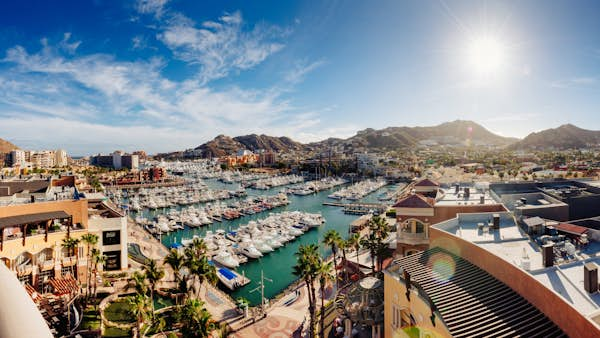


Find the best season for you to enjoy everything you want to do in Cabo
Picture-perfect Los Cabos offers a desert-meets-sea aesthetic, with gorgeous golden rock formations that tumble down to the wide-open Pacific Ocean.
Not to be confused with the West African island nation of Cabo Verde, Los Cabos is on Mexico’s Pacific Coast. Its anchor cities of Cabo San Lucas and San José del Cabo are jam-packed with many of Mexico’s top five-star hotels, and they’re loaded with a wide array of all-inclusive resorts. With so many beautiful beaches and flashy resorts, it’s no wonder why it’s quickly become one of Mexico’s top tourist destinations.
With that said, there is much more to this town at the tip of the Baja California peninsula than sprawling beach resorts. Cabo is also known for its world-class water sports, diving, yachting, culture, and events. Still, you have certain factors to consider when deciding your best time to visit Cabo. The winter and spring high season typically provides the mildest and driest weather, but it’s also the most expensive time to visit. On the flip side, summer’s low season often sports the lowest prices for flights and hotels, but it’s also the time when you need to be the most mindful of the potential for extreme weather.
While Cabo manages to keep things fun and enjoyable year-round, we want to help you figure out when is your best time to plan your Los Cabos trip. Here’s our season-by-season, month-by-month guide to the best time to visit Cabo.
December to April: Pick the high season for perfect weather
With average temperatures that range between a delicious 77 and 80 degrees Fahrenheit, most tourists consider high season their best time to visit Cabo. Thanks to cool breezes that ride in from the Pacific, visitors to Los Cabos can expect sunny and warm days with cooler desert nights. And since Cabo averages less than 1.5 inches (or under 3.5cm) of rain during these five months, you face the least risk of rain on your parade.
As Cabo is where the desert meets the sea, the cooler and drier winter weather makes this the best time for sightseeing around the region. From outdoor adventures like ATV riding and hiking, to visiting the nearby Pueblo Mágico (or Magical Town) of Todos Santos, winter is the prime time to experience the best that Cabo has to offer. If you’re into whale watching, winter is also the best time to spot pods of gray and humpback whales (and whale sharks) enjoying the warm and nutrient-rich ocean water.
But, of course, there’s a catch: The high season brings big crowds. If you come during the winter holiday season (Christmas and New Year’s) or spring break (March and April), you should expect top-shelf prices at Cabo’s resorts and restaurants. (Check our guide on where to eat in Los Cabos for some great restaurant recommendations!)

May to June: Pick the spring shoulder season for a quieter atmosphere
Cabo’s late spring shoulder season might be the destination’s best-kept secret. Not only are temperatures still perfectly pleasant (warm in the day, cool at night), but the majority of crowds have gone home. As a result, you’ll notice lower prices, and you’ll see that the frenzied, vivacious spring break scene gives way to much calmer vibes. Though the whales have left for cooler waters, the warmer sea water makes it more amenable for swimming. (Expect water temperatures in the mid-70s Fahrenheit during May and June.)
For Los Cabos’ most swimmable beaches, head to Medano Beach near the Cabo San Lucas Marina, Lovers Beach by the Arch at Land’s End, and the Santa Maria and Chileno Bay Beaches at the Tourist Corridor between Cabo San Lucas and San José del Cabo. These beaches have the safest and calmest sea water for swimming, making them some of the best free things to do in Los Cabos.
Come May and June, temperatures start to rise with daytime highs usually reaching the upper 80s. Also during this time, Cabo hardly gets any rain. With all that sunshine, the right amount of heat, and fewer crowds, you’ll see that the spring shoulder season makes for quite a lovely season in Los Cabos.
July to September: Rainy season brings the lowest prices
Late summer into early fall is when temperatures rise well into the 90s (Fahrenheit) during the day, bringing a thick blanket of humidity and plenty of rain. While the rain makes it a bit more difficult to catch those southern Baja rays, the weather brings with it a green, lush landscape that contrasts beautifully against the otherwise rocky desert environment.
Because this is the Pacific hurricane season, you may need to keep a close eye on the weather forecast in case a major storm makes its way to Los Cabos. Though direct hurricane hits are rare, summer thunderstorms are to be expected.
For this very reason, the tourist crowds thin out making way for the cheapest hotel rates and airfares. As long as you don’t mind damper weather and reduced operating hours at some restaurants and nightclubs, the summer season is ideal for bargain hunters.
October to November: Pick the fall shoulder season for great weather and great deals
October typically marks the tail end of the Pacific hurricane season. There’s still some risk of tropical storms reaching shore, but Cabo almost always gets more rain and storms during August and September. By November, Cabo turns bone-dry all over again. Temperatures usually only reach into the mid-80s (Fahrenheit) during the day and drop to the 60s at night.
While you’ll notice prices rising in time for the Thanksgiving U.S. holiday at the end of November, you’ll find a number of great deals earlier in fall. If you don’t mind hotter temperatures and some risk of rain, book an October trip to enjoy some of the lowest prices and smallest crowds outside the summer low season. For nicer weather and more activities in and around town, go in November.
Now that we’ve given you an overview of Los Cabos’ high, shoulder, and low seasons, here’s a more detailed month-by-month guide. Keep in mind that events and details are subject to change.
January
January is the coolest month in Los Cabos, but even the coldest day here is still pretty warm. Daytime highs almost always surpass 70 degrees Fahrenheit, and nighttime lows rarely fall below 50. Expect large crowds and high hotel prices through the first week of the month, due to New Year’s celebrations.
Key events: El Día de los Reyes Magos, Todos Santos Tropic of Cancer Music & Arts Festival
February
You’ll still be enjoying plenty of sunny days in Cabo, only this time with much more space to yourself. February offers a “sweet spot” of thinner crowds and pleasant weather, as it’s after the winter holidays and before the spring break rush.
Key events: Todos Santos Art Festival, Los Cabos Half Marathon
March
Daytime temperatures begin to inch their way into the 80s during the month of March, and with the start of spring break in schools, you’ll notice an uptick in both families and younger travelers looking to party poolside by day and bar-hop by night.
Key events: Cheese & Wine Festival
April
By April, US colleges’ spring break season is winding down, and Semana Santa (Holy Week) celebrations are kicking up in Los Cabos. Expect high room rates and lots of people out on the beaches, in the streets, and at the bars. Since Cabo San Lucas (at the southwestern tip of Los Cabos) has more of the luxury hotels and all-inclusive resorts catering to U.S. and Canadian travelers, expect a more exciting environment here. Meanwhile to the east of Cabo San Lucas and the Tourist Corridor of major name-brand resorts, San José del Cabo tends to be much more laid back. By the end of the month, the entire region begins to calm down as temperatures rise.
Key events: Spring Break, Semana Santa

May
May languidly rolls in on a heat wave. Yet it’s also one of the best times to visit Los Cabos because the vibe still hums with energy, especially if you’re a boater or a surfer. Surf season in Los Cabos runs from May through October, and you can expect good swells at various beaches from Todos Santos to San José del Cabo. May also brings thousands of aquatic enthusiasts to the marina to enjoy the Cabo Marine Show.
Key events: Cabo Marine Show
June
The southern tip of the Baja Peninsula is a tropical desert, and June weather will certainly remind you of that. The days stay hot, and precipitation is virtually nonexistent. But, that does not stop Los Cabos from hosting various events. From surf competitions to golf and music, Los Cabos has plenty to entertain.
Key events: Los Cabos Open of Surf, Stars & Stripes Fishing & Golf Tournament, Fiesta de la Música, Gala de Danza
July
Scorching temperatures peak in Los Cabos in July. You may see a rainstorm here and there, but precipitation is still pretty rare at the peak of summer. July begins turtle-nesting-season in Los Cabos. It’s also the peak time of year for summer vacations, which means beaches can be crowded and hotel occupancy high.
Key events: East Cape Dorado Shootout
August
Blazing temperatures and thick humidity continue. Thunderstorms start to become a more normal occurrence towards the end of the month. Still, fishing is in full swing in the Sea of Cortez.
Key events: East Cape Bisbee Tournament, Festival del Mango Todos Santos
September
Los Cabos crashes into September with a roll of thunder and heavy rain. While hurricane season is said to start in June, the roughest storms actually tend to hit in September. If you’re coming during this month, prepare for the possibility of multiple rainy days.
Key events: Mexican Independence Day
October
Storms continue into October, though they tend to taper off considerably when compared to September. October is also when Los Cabos begins to prepare for the rush of the holiday high season. Hotel rates start to climb, and the events calendar starts to pick up again, especially when it comes to fishing tournaments.
Key events: Los Cabos Billfish Tournament, Bisbee’s Los Cabos Offshore Tournament, Bisbee’s International Black & Blue Tournament, Fiestas Tradicionales Cabo San Lucas, Los Cabos Gran Fondo
November
After months of heat and humidity, the temperatures start to feel considerably cooler in November and the rain starts to fade away. Peak season is just around the corner, so it’s best to book November travel a few months in advance to secure lower prices, especially if you’re planning for a tropical (and popular) Thanksgiving getaway.
You’ll also notice a busier event calendar in November, which includes events like the San José del Cabo Art Walks and the organic market.
Key events: Day of the Dead, Los Cabos International Film Festival, Todos Santos Film Festival, VIP Summit

December
Peak season officially kicks off when the calendar flips to December. This month kicks off whale watching season and crowds start to arrive in droves. Hotel rates reach all-time highs, especially around Christmas and New Year’s Eve. Still, this is one of the most energetic times to be in Los Cabos, with holiday celebrations, foodie events, and many parties to enjoy.
Key events: Gastrovino Baja Food & Wine Festival, Sabor a Cabo Festival, Las Posadas Christmas celebrations, New Year’s Eve Fireworks
You might also like:
Where and what to eat in Los Cabos right now
Why Los Cabos needs to be next on your travel list
Top 10 things to do in Cabo San Lucas

15 things you absolutely must do in Central America
The Central American isthmus consists of seven countries, two expansive coastlines and more than 100 volcanoes. Add it all up, and you’ve got one of the most exciting regions in the world to explore.
Options for adventure travelers and nature enthusiasts are ubiquitous, and you’ll also find plenty of relaxed island getaways, magnificent Maya ruins and bustling cities. Whatever your travel preferences, Central America can satisfy them.
Whether you’re a first-time visitor or a repeat customer, knowing where to start can be a challenge – but it’s also part of the fun. In this roundup of Central America’s best experiences, we’ll guide you on where to find monkeys, how to choose islands, which volcanoes to summit and who throws the best parties. ¡Vamos!
1. Island hop in Bocas Del Toro, Panama
With nine main islands and some 200 islets, this stunning archipelago looks like a series of eye-catching postcards and is unsurprisingly Panama’s most popular vacation spot.
Its dockside hotels and restaurants, low-hanging palm trees and crystal-blue water have for many years attracted international travelers. Some have even refused to go home.
Activities of choice include pedaling a beach cruiser around, snorkeling among giant sea stars, surfing reef breaks, touring chocolate farms and feasting on delicious Caribbean fare.
In the evenings, Latin rhythms and clinking glasses fill the air on backpacker-y Isla Colón.
2. Meet wildlife on Costa Rica’s Osa Peninsula
The wildest of the wild in Costa Rica, this national park on the country’s most secluded peninsula explodes with biodiversity and eye-popping ecosystems.
In the same afternoon, you can traverse a gnarled, dripping rain forest, cross a waist-deep river and take lunch on a wilderness beach – and you’re all but guaranteed to encounter dangling monkeys, shy tapirs and squawking macaws.
It’s usually intrepid types who venture out here, as the terrain is rugged and remote. But the trails are in good shape, and a guide is required (which is great because getting lost would suck).

3. Self-reflect at Guatemala’s Lago de Atitlán
Outsiders tend to fall in love with Central America’s deepest lake, extending their trips by weeks or even years – and for good reason.
Ringed with lush hillsides, towering volcanoes and diverse communities, this crater lake and its aquamarine waters, a highlight of any Guatemala trip, offer an escape to a simpler way of living.
On an Atitlán getaway, travelers can do it all: some learn Spanish, practice yoga and stay with a local family; others long-distance kayak, scale volcanoes and throw down with other backpackers in San Pedro La Laguna.
Whatever you do here, take some time to relax and reflect by this glorious lake as the rustic fishing boats glide by.
4. Explore Mayan ruins in Honduras’s Copán
Tucked into an idyllic river valley, these archeological ruins were home to a Maya civilization whose artisans could carve stone like few others.
The sculptures here are particularly impressive – don’t miss the hieroglyphic stairway – and a day spent peering around these temples and the surrounding sites will make you feel like a time traveler.
Thereafter, you can retreat to the neighboring town of Copán Ruinas and its lovely boutique hotels or stay in the pine-forested hills at Hacienda San Lucas. Day trips north for a soak in hot springs at Luna Jaguar Spa Resort are to be savored.
5. Plunge into Belizean waters
Undersea adventures are off the hook around the atolls of Belize, where snorkelers and divers glide over spectacular coral formations and encounter majestic marine life, including reef sharks.
At the world-famous Blue Hole, divers submerge more than 100 feet into a massive marine sinkhole.
Reputable tour operators with excellent customer service and solid environmental credentials abound.
And bold travelers seeking a highly personal and adventurous experience should consider a stay on the castaway-esque island Long Caye, which is just minutes from the country’s most coveted underwater attractions.

6. Explore Guatemala’s colonial gem, Antigua
Central America’s top colonial showpiece is an enchanting amalgam of cobblestone, crumbling ruins and elegant churches. To comply with its World Heritage listing, the former Guatemala capital hides all evidence of modernity behind traditional pastel facades, and its plazas and markets pulsate with local life.
If you ever tire of wandering these charming streetscapes (which you won’t), you’re also well-placed to venture into the surrounding countryside, where traditional Maya communities, verdant coffee plantations and smoking volcanoes await.
7. Road trip through El Salvador’s Ruta de las Flores
Flanked by wildflowers, this scenic 20-mile road through multi-hued colonial villages and undulating coffee plantations is a journey into the heart of El Salvador.
It is best undertaken on weekends when the cobbled streets of five main settlements come alive with local food festivals. The Feria Gastronómica in Juayúa is particularly delicious.
Regardless of when you go, there will be ample opportunity to shop for artisanal crafts and sample the coffee.
Not too far off the route, Los Chorros de Calera offers hiking and swimming near a series of waterfalls spilling from fractured cliffs.
8. Feast on the Corn Islands’ Caribbean fare
Foodies who land in Central America simply cannot miss the lip-smacking Caribbean cuisine, and there’s no better place to sample it than on Nicaragua’s dreamy Corn Islands.
We’re talking scrumptious lobster, whole fried snapper, heaping plates of coconut-y rice and beans, and (best of all) the rondón.
Essentially the jambalaya of the Caribbean, this local favorite features sea bass or snapper, shellfish, tubers, plantains, heart of palm, plantains, peppers and a host of spices.
Local restaurants on Great Corn – the larger and busier of the two islands – serve this stew year-round. Be sure to give 24 hours’ notice for your order, though, as the ingredients must simmer in a spicy coconut broth all day. The islands also throw a festival dedicated to crab soup every August.
9. Move-and-shake in Panama City
Welcome to Central America’s most hustling, bustling capital city. You could almost mistake the place for Miami with all its steel and glass towers – but the glittering skyline is only the beginning.
We recommend staying in the historic district, Casco Viejo, whose restored colonial buildings now house boutique hotels, swank restaurants and rooftop bars. You’ve also got the crumbling ruins of Panama Viejo, the rollicking nightlife of Calle Uruguay and an abundance of casinos all over the city to keep you entertained.
A short drive west, you can visit the world-famous Panama Canal and its impressive lock system. Rainforest and beach destinations are also within striking distance.
10. Live it up in El Salvador’s Playa El Tunco
El Salvador’s most famous beach is a hard-partying black-sand paradise with killer beach breaks and a distinctive pig-shaped rock formation just offshore. (“Tunco” means pig)
Weekends are an absolute scene with both locals and tourists, and hangovers are best nursed with thin-crust pizza at Tunco Veloz.
Other nearby beaches are much more chill, particularly the windswept wilderness of Barrio Santiago, where turtles hatch along the shore.

11. Volcano-board in León, Nicaragua
There is just one place in the world to “send it” down the sooty terrain of a volcano: Nicaragua’s Cerro Negro, just outside of León.
The little-known sport essentially involves dressing up in an orange jumpsuit, a helmet and safety goggles and carrying sled-like equipment up over lava-baked rocks.
Then, you hurl yourself down the sulfur-spewing cinder cone’s ashy flank. The idea is to go fast, but not so fast that you wreck. What’s not to love?
For the full experience, stay at the Bigfoot Hostel, a vibrant backpacker joint formerly owned by the inventor of volcano boarding. Go with one of their group tours and have a Toña beer once you’ve survived.
12. Learn to scuba dive in Utila, Honduras
If you’re looking for big experiences on a small budget, consider taking the plunge off Utila, one of the world’s least expensive places to get scuba-certified.
The balmy, turquoise waters off this palm-flecked Caribbean isle simply teem with colorful coral and curious fish.
Enormous whale sharks have been known to chill on the northern tip of the island all year round, and the tasty seafood and lively bar scene are nothing to scoff at, either.

13. Surf Nicaragua’s Pacific Coast
Ever since Endless Summer II hit the big screen in 1994, surfers have been flocking to Central America’s Pacific Coast for its temperate sea and uber-consistent swells.
The film featured Costa Rica’s Tamarindo, and certainly that beach is a surfer’s paradise. But just a few hours north in Nicaragua, things get a bit more adventurous and a lot more affordable.
The former fishing village of San Juan del Sur is now Nicaragua’s jumping-off point for all things surf, but its waves are unremarkable compared to the point breaks and beach breaks found in the secluded bays to the north and south.
The hollow tubes rolling into Playa Maderas are world-class, and the backpacker beach vibes are strong.

14. Zip-line through the Monteverde forest canopy
We know, we know: there’s nothing more touristy than strapping on a helmet and shimmying into a harness to zip around a Central American forest like some oversized hummingbird on a bender. But the rush is undeniable, and if you’ve never done it, you need to.
There is no shortage of zip lines, particularly in Costa Rica, where the tourist attraction was invented. We are partial to forest flying in the adventure parks of Monteverde, where businesses have stepped things up with Tarzan swings, rappels through tree centers and treetop walkways.
When you’re done, head to the Tree House Restaurant for a delicious passion-fruit smoothie.
15. Do nothing on Caye Caulker in Belize
Sometimes travel can feel a bit hectic. Rest assured that this will never happen on this blissed-out tropical dream island. Think sugar-white sand, warm azure waters and beach bars serving up fruity cocktails and pumping reggae tunes all day long.
Nights are on the quiet side, which tends to draw a chilled-out, international backpacker crowd and plenty of families.
For visitors who insist on doing stuff, there are plenty of opportunities for snorkeling around with turtles and small sharks, spying on manatees or kayaking to lesser-explored parts of the island.
You might also like:
6 road trips in Costa Rica that aren’t for the faint of heart
Central America’s most thrilling volcano adventures
Why you should take a cacao tour in Latin America






